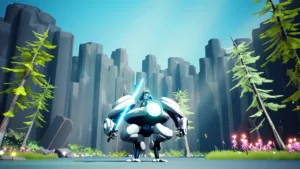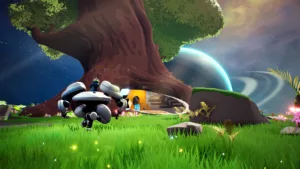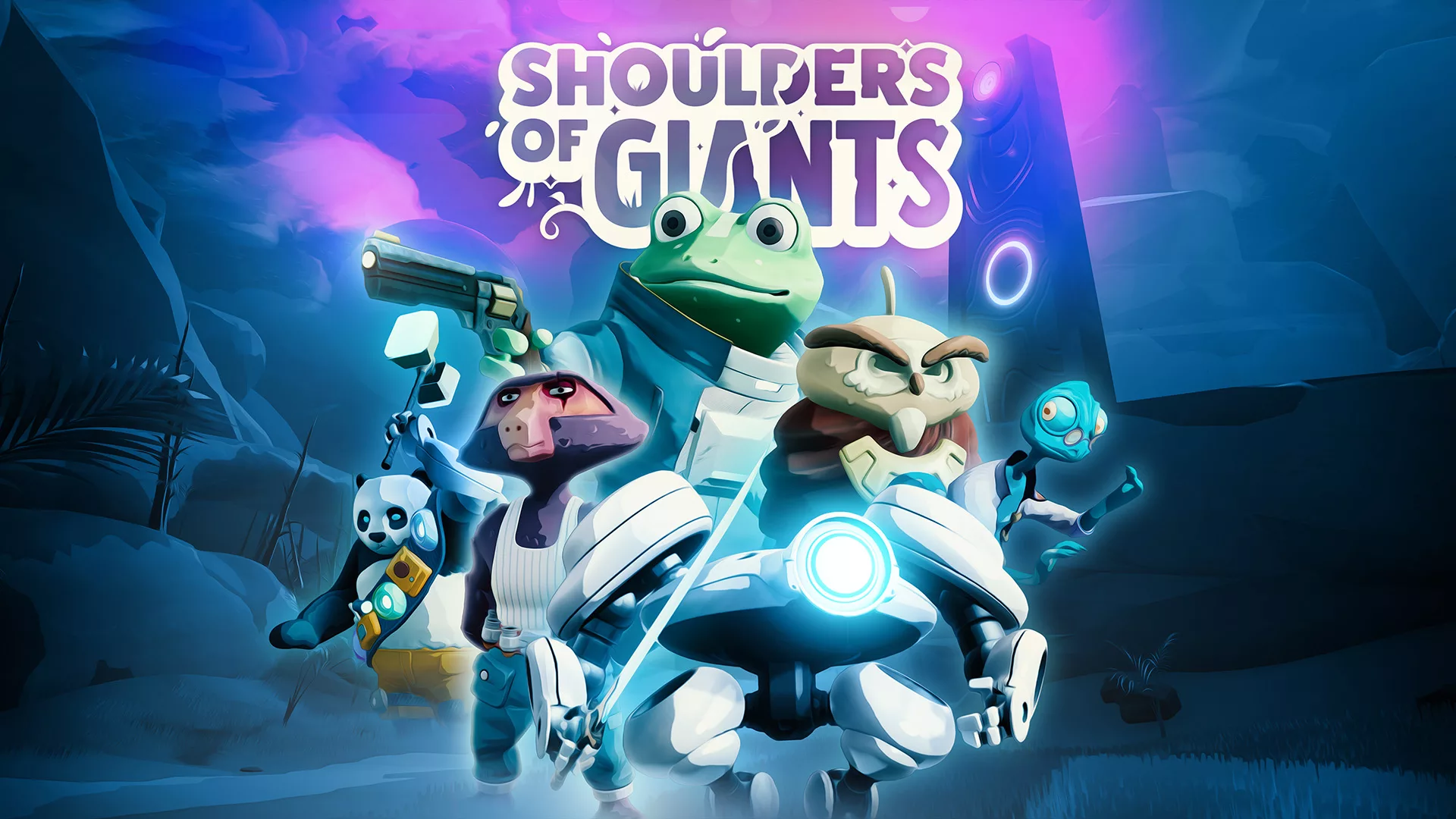If you’re a fan of roguelites then you will be very familiar with a game called Risk of Rain 2. That game was a massive hit in and out of early access and really set the bar for the genre in terms of quality and addictive gameplay. This is why I was incredibly excited when I came across Shoulders of Giants. Another game with a similar premise to Risk of Rain 2 but with a very colourful art style, giant mechs and fluid combat. Being in the same genre with some of the most well crafted games around, I think Shoulders of Giants certainly stands up well and holds its own.
The story of Shoulders of Giants is about as basic as it gets. You and your ragtag team of allies must cut through waves of enemies on a quest to rescue the galaxy from the forces of Entropy.
Throughout the game you will be speaking to your allies in your hub world and meet 4 unique characters who will help you on your journey, all of which have some pretty generic titles such as Panda and Monkey. Each of these characters will provide you with a small amount of dialogue or quest to complete when going on your so called ‘runs’. However we must remember that most roguelikes are not heavy on story as instead most of us gamers want to sit down, blast and dice our way through waves of enemies. Each of characters within the game do provide services as well within the hub world but more on that later on in this review.

Now the core gameplay loop in this game is not what I expected when diving straight in. I think many of us looked at the game from trailers or by watching gameplay and thought it was an immediate rip-off of risk of rain, however I was pleasantly surprised. Instead of the usual continuous teleporting and getting to a high wave then dying, the game instead provides you with a specific mission to complete per biome and once
finished you are teleported back to the hub world. Once you finish a mission you level up a bar otherwise known as HEAT, get XP for levelling up your character as well as potentially getting new cores and weapons.
Getting your HEAT level higher is the main aim of the game overall and this introduces a very good morality system as you either have to play the game safe or risk it all for a higher reward or otherwise lose HEAT from
your existing tally. This is a fantastic mechanic added to the game and really emphasises the risk and reward when going on missions and makes you think how you’re going to upgrade your character with the limited XP
given. I found that I had to be very methodical with choosing my character upgrades as potentially the wrong choice could put me further back and not progress the story.
So to go ahead with each mission you will go up to chameleon at the telescope and scout out your mission that you want to proceed with. You are always given a selection of 3 planets to choose from and these will range in difficulty from easy, medium and hard which you will notice from the HEAT level. The higher the HEAT the harder that planet will be to conquer but the rewards given will be much more lucrative. There were many times I would gamble to get a higher reward containing more HEAT, better cores and weapons but I would fail at the last hurdle and my progress was put back due to my error in judgement. It really puts the
weight in all decisions made in this game and ultimately decides how long the game’s main story will take you. When you reach your heat target which is ultimately every 1000 you will then come across a boss which is
solely made for the story. This is a great addition as it varies up the enemies that you are coming against and are usually the hardest battles you are given.

You may be wondering though what sort of missions you will come acrosson each planet and at the moment there are only 3 in variety within the game. We will cover each of these now and they are pretty simplistic in
nature.
The first is called Conquest and all you have to do is go around the map and find these so-called spires. These are essentially small little monoliths that have orbs circling them and you have to destroy them to release a
small grasp of the world that has been taken over. Once taking on these spires there will be a large group of enemies that will spawn and try to stop you from taking these out. Usually you will have to take out 2 or 3
spires and once complete you will have to find the largest monolith on the map. Upon going into this section you will have to either fight the largest waves of enemies yet or take on a very uniquely designed boss.
The second is called Storm and was my least favourite out of all the missions. This entails taking your character and finding your way to the monolith whilst in the midst of a dark and awful storm. Whilst on your way there will be a massive wave of enemies that are constantly spawning and can ultimately get incredibly difficult to deal with. When you eventually find the monolith again you will fight a wave of enemies to complete that specific mission.
The final type of mission is called Butterflies and your objective is to go around the area you spawn in and defeat enemies with a red gem above their heads. This is the most simplistic out of all the missions but it does
make for some challenging combat especially when coming up against a massive group of enemies all at once.
This layout of different missions to complete is a great twist to the usual roguelike formula as you finally feel some accomplishment for defeating and surviving waves of enemies instead of just dying and trying over and
over again.

Now in terms of combat this is where the game shines and from the 15 hours I’ve put into the game, it is incredibly smooth and well polished. When going through each of the missions you will have your standard
attack which is either from shooting when aiming down the sight with your character or using a melee attack with your mech. There are alot of power ups within the game and usually these are scattered around the map and provide your character with different buff, attack styles and healing items. To get these items you need to have generated enough energy which is picked up from defeating enemies. You will however always have abilities off the cuff which is part of your CORE powerup which you can choose when you’re back at the home base. As to be expected though some power ups are incredibly powerful and can decimate your opponents
whereas others are simply useless. I always found that combat was well balanced and easy to control when in both large and small encounters and the hit registration was always on point. The one thing you always want in a roguelike is swift and accurate combat mechanics and Shoulders of Giants certainly shines in this department.
Now I want to dive a bit more in detail regarding the levelling up and crafting within the game. As mentioned, once completing your missions and returning to the hub area you would have been given XP, you can use
this to either upgrade your character through a wide and varied skill tree or use it to unlock skins for your frog and mech. I would always heavily recommend levelling up your character as the XP given is always in short
supply and the skins provide no benefits. With the skill tree it contains a lot of upgrades and these can be for either your frog, mech, world elements or even both combined. There is a lot here to dive into but I wholeheartedly recommend you peruse this expansive list before deciding on what to level up.
In terms of crafting and decking out your characters you will come across a couple of vendors each of which provide you with weapon options for both your frog and mech or as mentioned previously, CORES which give
you a buff and 2 abilities. The weapons on offer in this game bring a real diversity to combat based on what you decide. You will always have a melee weapon and a long range weapon. These are rather diverse and range from Rocket Launchers to machine guns and boxing gloves to swords and shields. These will change your gameplay style and its great to experiment and find the right fit for you. If you find you have too many
weapons or cores available then the crafting system is there to help you.
Once you have 3 items you can ask the vendor to craft a new weapon or core for you and this is always
random and can sometimes be fantastic or down right dreadful. It’s a fairly basic system but it does what it says on the tin.

One area of the game I did not manage to test out very often was the co-op mechanics. The game does support up to 4 players at one time but with me playing within the review embargo there were not many players
about. The times I did find a game with another player were very enjoyable and I didn’t seem to run across many issues. The ping system is fairly lacklustre as you cannot seem to ping a pick up or health item and I
could foresee this being an issue especially if players are wanting to communicate without a microphone. Overall the searching system and hosting of a game is very straightforward and I have no doubt the game
will flourish with the addition of a multiplayer element.
Well you may be thinking this game sounds fantastic and you can’t wait to dive in however there are some negatives to the game and I will run through them now.
First of all there were some performance hiccups I found in the game and this was unexpected as it was during encounters with a rather small group of enemies. This did happen to me a few times during my entire 15 hour playthrough and does hinder the game when you’re trying to dodge enemies and their attacks. Usually I would have brushed past this especially in the later levels with lots of enemies and this is usually what happens in most roguelite experiences, however I could not ignore the stuttering and huge frame dips when in pretty important encounters. The developers are due to update the game to unreal engine 5 in spring so
hopefully these issues can be fixed with relative ease.
Now one area that kept being brought to my attention throughout my experience was the pacing. Now I know that roguelikes can take time to build up your character and the waves of enemies etc etc. however there
were certain missions that I went into and the pace was just completely off the mark. Sometimes I would be walking between objectives and literally next to no enemies would spawn and it felt more like a walking
simulator. Don’t get me wrong the environments are well done and have a wide variety however some areas were way too big for the little amount of enemies being spawned in. When you’re going into a roguelike you want action, action, action however this game had more of a stop start appeal which can be to some players joy but to many gamers misery.
A final issue that I came up against time and time again was the storm missions and I really wish these were not in the game. It is a unique concept however the execution is somewhat poor and not well designed.
There were many occasions where I was spawned into this mission and it was so dark I could not see a single thing ahead of me. The only way I managed to get out of these horrid levels was to either die or stay so
close to a wall so I could barely see the outline and find my way. So many times this was an issue and I spent easily 20-30 minutes just trying to get out of these. I hope the developers fix the brightness levels of these
encounters as some are purely unplayable.

So with all of that said, what did I think of my time with Shoulders of Giants and does it make for a Roguelike experience that you need to dive into. Well the game provided me with some very awesome encounters and at times incredibly addictive gameplay with its unique take on the roguelike formula. I did have a few issues and some were painful at times and took me out of the experience but I still went back into the game just to complete one more run. When a game can grab you back in with its fluid combat and interesting formula then you know it could be onto something great.
Game played and reviewed by Fletch (Xbox Nation) , who we are welcoming to the Completexbox family as a staff writer. You can interact with Fletch more by following him on twitter, or by heading to his fabulous youtube channel Xbox Nation
Overall
-
CX Score - 70%70%
70%
Summary
Pros
- Fluid and Addictive Combat
- Satisfying Progression System
- Fantastic OST
Cons
- Occasional performance dips
- Some levels can feel bare in the early game

